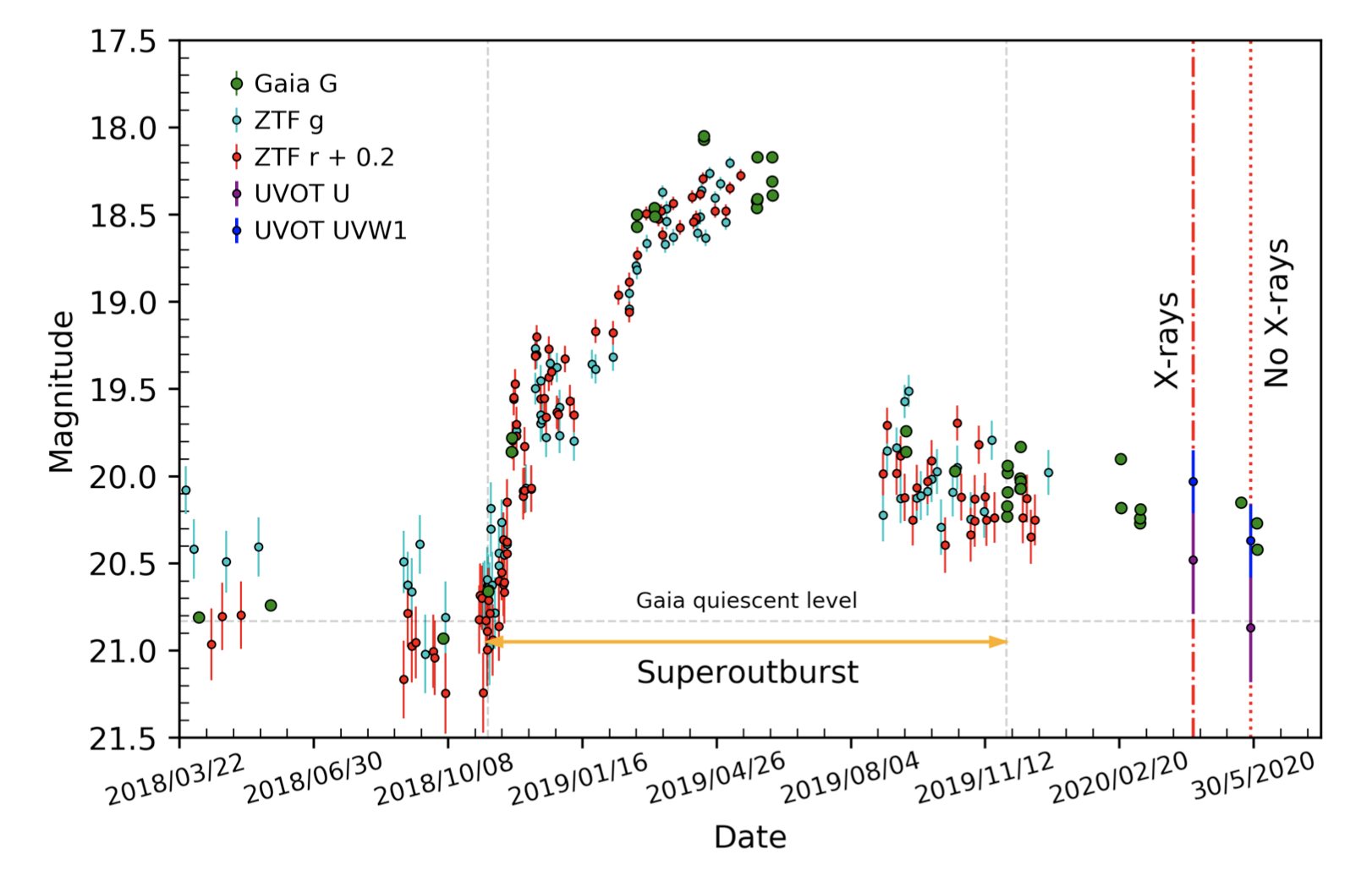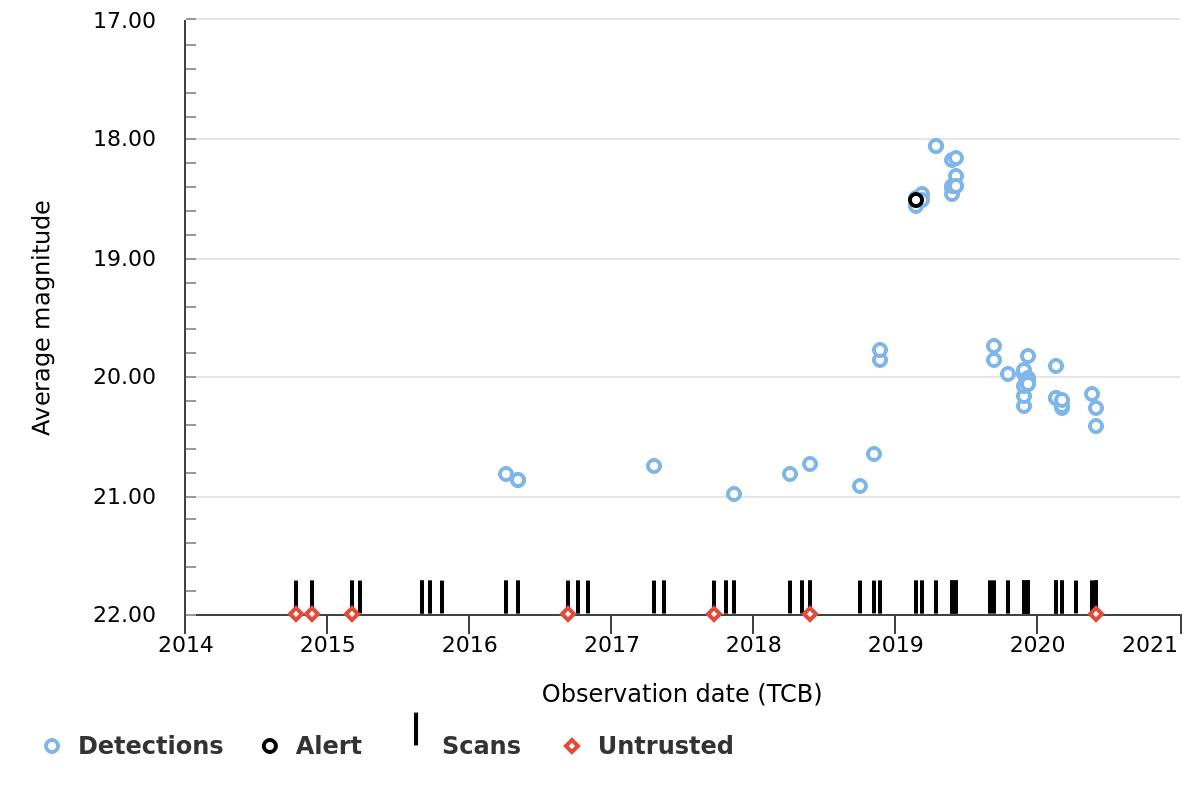IoW_20200904 - Gaia
Image of the Week |
Discovery of a year long superoutburst in a white dwarf binary |
|
Figure 1: Light curve of SDSS J080710.33+485259.6 (or Gaia19atk) with data from Gaia, ZTF and Swift-UVOT. The horizonal line denotes the average quiescent value determined from Gaia data, additional Gaia points are not plotted. The orange arrow indicates the duration of the superoutburst. ZTF and UVOT magnitudes are given in AB system. A constant factor has been added to the magnitudes of ZTF-r to match the quiescent level of Gaia measurements. The vertical lines accompanying the Swift UVOT measurements indicate whether X-rays were observed or not by Swift XRT. The period with no data during the superoutburst was caused by the binary being occulted. Credit: Rivera Sandoval et al. 2020 |
|
SDSS J080710.33+485259.6 is an accreting ultracompact white dwarf binary (AM CVn) with an orbital period of approximately 53 minutes. On 8 April 2016 Gaia first observed the source at a magnitude of about 20.8. On average Gaia observes a star about 70 times over a 5-year period. These many data points gathered allow to see a brightening if the source goes into outburst. The Gaia Photometric Science Alerts team keeps an eye out for the sources that suddenly dim or brighten and then sends out alerts to allow the astronomical community to plan a follow-up on the interesting sources. Such an alert, for this source called Gaia19atk, was announced on 26 February 2019, when the star was observed at a Gaia magnitude of 18.51, being clearly brighter now which suggested the binary to be in outburst. With the alert sent out, the Gaia epoch data for the source was then published on the Gaia Photometric Science Alerts page for Gaia19atk and some follow-up was performed. Looking at the observations from Gaia, one could see that the outburst already started earlier, in November 2018 when the source was seen to be one magnitude brighter than its quiescent level (Kupfer et al. - ATel 12558). For most sources, the epoch data as obtained by Gaia are not yet available. Gaia epoch data for all Gaia sources are planned to be released with Gaia Data Release 4, and the Gaia Data Processing and Analysis Consortium is continuously developing pipelines, improving calibrations and scaling up the processing to allow for the vast amount of data to be published. But for these sources that qualify for an alert, the preliminarily calibrated Gaia epoch data is published when the alert is announced. A team of Texas Tech University took a closer look at Gaia19atk and its outburst, which is actually the first ever detected for this source. The outburst started in November 2018 and lasted for a year, making it the longest superoutburst known so far for any short orbital period accreting white dwarf. The team published their results in their paper titled "A year long superoutburst from an ultracompact white dwarf binary reveals the importance of donar star irradiation" which was just accepted by ApJL. To determine the presence of an outburst, it is very important to know the quiescent level of a source. Thanks to Gaia's great sensitivity, the observations made from 2016 to early 2018 formed a great base to determine the 20.8 mags quiescent level of Gaia19atk. Given the faintness of the object in its quiescent level, the source was not easily detectable through small ground-based telescopes, and if detected, the photometric errors were often large. Only a few other facilities, like the Zwicky Transient Facility (ZTF), provided extra data for this case. The observations by Gaia and ZTF can be found in Figure 1 above. The lightcurve composed of Gaia observations only, can be found in Figure 2.
Figure 2: Light curve of Gaia19atk, taken from the Gaia Photometric Science Alerts page. Image credit: ESA/Gaia/DPAC and the Gaia Photometric Science Alerts team.
The data provided by Gaia were essential to determine the amplitude, the duration, as well as the rise and decline rates of the superoutburst of this source. These observables are important factors to help understanding the outburst mechanism. Rivera Sandoval et al. show that the outburst of Gaia19atk lasted for a year, with extremely slow rise and decline rates which are atypical features under disk instability models. In fact, the extreme observed values for this binary have not been observed before in any accreting white dwarf either with Hydrogen or He-rich donors. These findings challenge the commonly invoked disk instability model for He-rich disks. Instead, the results indicate the need for irradiation-induced mass transfer, a mechanism which has been suggested to be important in these ultrashort period binaries, but never unambiguously proved. Looking at the last Gaia data points of June 2020, one can see that the source is still brighter than its initial quiescent level. This extra brightness near the end of the outburst triggered the research team led by Rivera Sandoval to perform some X-ray and UV follow-up observations with the Swift observatory, also seen in Figure 1. A variable X-ray behaviour was spotted during this post-outburst cooling phase. The findings about Gaia19atk will hopefully help to understand how the accretion process in these binaries occurs. These results may also be relevant for space-based gravitational wave observatoires, such as the upcoming LISA mission. This because the irradiation-induced mass transfer mechanism may substantially influence the evolution of these binaries, potentially affecting the expected number of individually detected ultracompact white dwarf binaries. Gaia has been operating now for more than 6 years, and is expected to scan the sky for several years to come, adding more and more observations to the lightcurves of its sources with each extra year of operations. With Gaia Data Release 3, a data set called the Gaia Andromeda Photometric Survey consisting of the photometric time series for all Gaia sources located in a 5.5 degree radius field centred on the Andromeda galaxy can be expected. Epoch data for all Gaia sources will become available with Gaia Data Release 4.
|
|
Credits: Rivera Sandoval L.E., Maccarone T.J., Pichardo Marcano M. from Texas Tech University, Gaia Photometric Science Alerts team [Published: 04/09/2020] |
- Removed a total of (8) style text-align:center;
- Removed a total of (5) style text-align:justify;
- Removed a total of (1) border attribute.
- Removed a total of (1) cellpadding attribute.
- Removed a total of (1) cellspacing attribute.
Image of the Week Archive
- Removed a total of (1) border attribute.
- Removed a total of (1) cellpadding attribute.
- Removed a total of (1) cellspacing attribute.








































 Sign in
Sign in
 Science & Technology
Science & Technology

